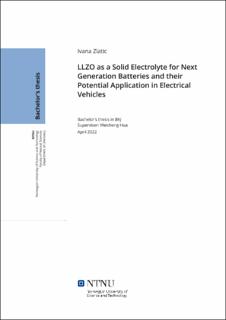LLZO as a Solid Electrolyte for Next Generation Batteries and their Potential Application in Electrical Vehicles
Bachelor thesis
Permanent lenke
https://hdl.handle.net/11250/2997780Utgivelsesdato
2022Metadata
Vis full innførselSamlinger
- Institutt for kjemi [1386]
Sammendrag
Faststoff-batterier anses å være oppfølgeren til konvensjonelle flytende elektrolyttbatterier, til og med forventet å overgå dem når det gjelder kapasitet, sikkerhet og levetid. Dessverre står denne teknologien overfor utfordringer som den manglende ioniske ledningsevnen til faste stoffer, ustabil fast elektrolytt-interfase og dens avhengighet av opprettholdelse av fysisk kontakt mellom elektroder og elektrolytter. Granattypen Li7La3Zr2O12 har fått mye oppmerksomhet i nyere tid på grunn av sin høye ioniske ledningsevne opp til 10^(−3) S cm^(−1) , brede elektrokjemiske stabilitetsvindu i området 0,0 V - 4,3 V vs. Li+/Li og stabilitet mot metallisk litium. Hvis granaten anvendes med litiummetall i et batteri, kan utviklingen forventes å være spesielt til fordel for transportsektoren og elektriske kjøretøy som kan få økt rekkevidden. Denne artikkelen presenterer utsiktene for denne nye teknologien og vil sammenligne, analysere og dissekere granatmaterialet som en fast elektrolytt for neste generasjons batterier. Solid state batteries are considered to be the sequel to conventional liquid electrolyte batteries, even expected to surpass them in terms of capacity, safety and cycle life. Unfortunately, this technology faces challenges such as the lacking ionic conductivity of solids, unstable solid electrolyte interphase and its dependence on the maintenance of physical contact between electrodes and electrolytes. The garnet-type Li7La3Zr2O12 has gotten a lot of attention in recent times due to its high ionic conductivity up to 10^(−3) S cm^(−1) , wide electrochemical stability window in the range of 0.0 V - 4.3 V vs Li+/Li and stability against metallic lithium. If the garnet is successfully applied with lithium metal in a battery, the evolution can be expected to especially benefit the transport sector with electrical vehicles being able to increase their driving range. This paper presents the prospects for this new technology and will compare, analyze and dissect the garnet material as a solid electrolyte for next generation batteries.
